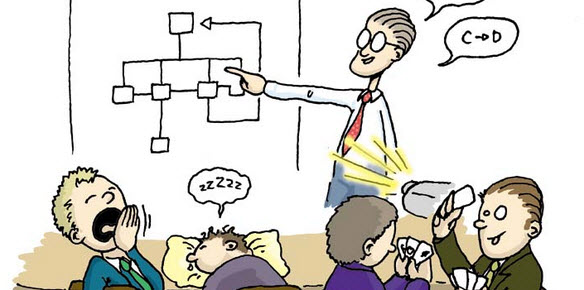One fine day in January of 2009, on a plane ride from San Francisco to Las Vegas with two of my closest friends, I learned how to deploy a life vest.
It was not my first time hearing an airline safety speech– by then I’d already flown over a dozen times. It was, however, my first experience with Virgin America. Rather than having two flight attendants battle it out for Most Lackluster Performance Under Fluorescent Lighting, Virgin broadcasts a safety video to its passengers via a touch-screen entertainment system installed in each headrest.
The video is illustrated with what looks like hand-sketched cartoons, and it uses both humor and good ol’ common sense to communicate vital information. The result? I can deploy the hell out of a life vest. And activate an oxygen mask. In my sleep, probably. (Virgin is also hip enough to have a YouTube account, and you can watch their safety video here.)
Business-to-Consumer Betterment
On a perfect planet, we would all pay close attention to important information simply because of the fact that it’s important. But this is Earth. We have short attention spans. We want information delivered in quick hits. Incomplete sentences, even.
Virgin’s strategy for getting around these obstacles is one that is proving more and more useful as technology continues to influence our expectations: They humanize the data. In human words, they make it relatable.
For example, the video’s narrator has a very tired voice, indicating that even the airline knows that what they’re telling you is something you’ve probably heard a ton of times. Just that little bit of empathy is enough to encourage an audience to pay attention.
Business-to-Employee Betterment (Yes, Please!)
When considering ways we can reshape the workplace to reflect today’s values and work better together, doesn’t it seem like applying this strategy could work wonders? Think about it: All that information presented by your CEO at company meetings– how many employees would be able to repeat it a day (or even an hour) later? I’m willing to bet not many.
As Director of Digital over at The Onion, it’s pretty much Baratunde Thurston’s job to grab people’s attention. I asked him about translating that over to an internal process, and this is what he had to say:
“There’s a lot of value to be found in smaller group meetings, if they’re feasible, because people respond better when there’s constant back and forth communication. You get to hear about the bad experiences right along with good ones, which can reveal some pretty big opportunities for improvement. Big company meetings can be difficult because employees don’t relate to the CEO or other executives as much as they relate to each other.”
Boom. There’s that whole humanization thing again.
In business land, this notion also speaks to the growing correlation between transparent leadership and productivity. Employees really do want the things that their bosses want for them (to be in the loop; to have a solid sense of trust and company awareness; to share their experiences for the greater good) they just need information and engagement opportunities to be brought down to ground level first. As we continue into 2012, I hope we’ll see a lot more processes that answer this need, and a lot more leaders getting down in the dirt right alongside their people.

